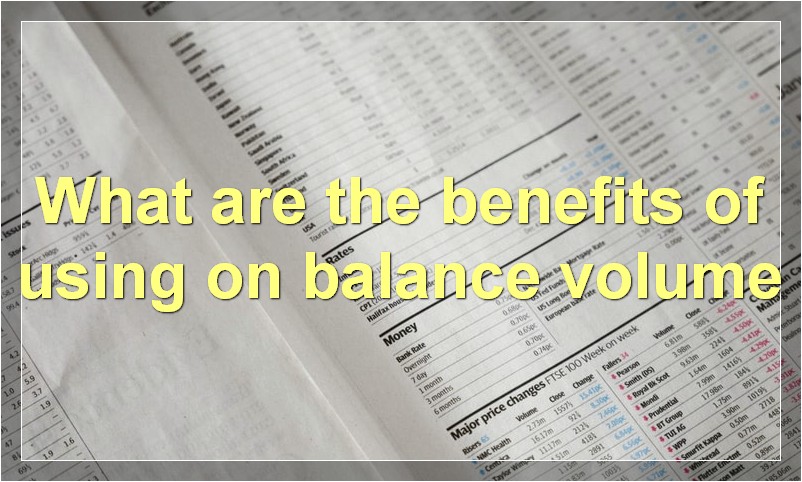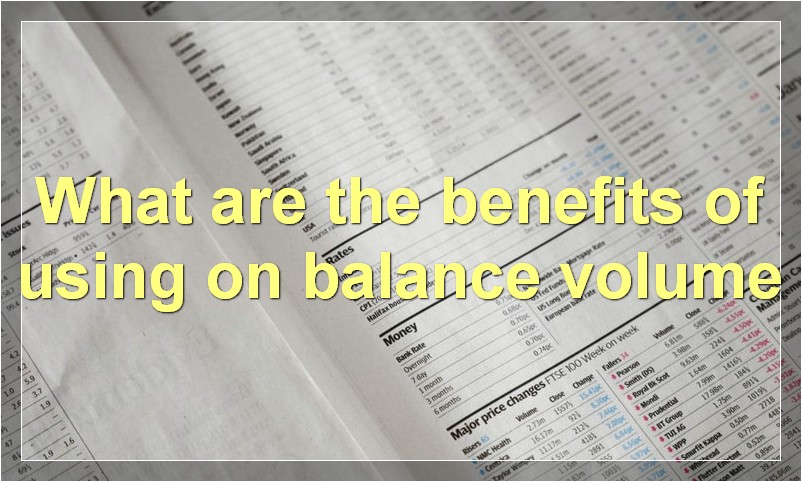On balance volume is a technical indicator that uses volume data to predict changes in stock price. Many traders believe that on balance volume is the ultimate guide to trading, as it can provide clear signals about when to buy and sell.
What is on balance volume
On balance volume is a technical indicator that uses volume to predict changes in stock price. This indicator is based on the theory that changes in volume precede changes in price. If the volume of a stock is increasing as the price increases, then it is said to be on balance. This indicates that there is buying pressure and the stock may continue to rise. However, if the volume decreases as the price increases, then it is said to be off balance and this may indicate that the stock is overbought and may soon start to fall.
What are the benefits of using on balance volume

On balance volume, or OBV, is a technical analysis indicator that uses volume data to predict changes in stock price. OBV is calculated by adding the day’s volume for each period to a running total. If the stock price closes higher than the previous period’s close, the volume is added to the total. If the stock price closes lower than the previous period’s close, the volume is subtracted from the total. The OBV indicator can be used to identify trends and predict future price movements.
Some of the benefits of using OBV include:
-The ability to identify trends: OBV can be used to identify both short-term and long-term trends.
-The ability to predict future price movements: By analyzing volume data, OBV can be used to predict future changes in stock price.
-The ability to confirm other technical indicators: OBV can be used to confirm trends identified by other technical indicators, such as moving averages.
Overall, OBV is a helpful tool for any investor looking to make better informed decisions about when to buy and sell stocks.
How is on balance volume calculated
On balance volume (OBV) is a technical analysis indicator that uses volume flow to predict changes in stock price. Joseph Granville first developed OBV in the 1963 book, Granville’s New Key to Stock Market Profits.
OBV is calculated by taking the difference between the volume of shares traded on up days and the volume of shares traded on down days. This difference is then added to a running total. If the stock price is increasing and the OBV is also increasing, this is considered a bullish signal.
There are a few different ways to interpret OBV:
1. As a standalone indicator: OBV can be used to confirm price movements or predict future price movements. For example, if the stock price is rising but OBV is not, this could be a bearish sign indicating that the rally is not supported by enough buying volume.
2. In conjunction with other indicators: OBV can be used in conjunction with other technical indicators to form a trading strategy. For example, some traders may use OBV to confirm breakout signals from other indicators such as Bollinger Bands.
3. As part of a broader trading system: Some traders build comprehensive trading systems that use OBV as one of many inputs. These systems may take into account a wide variety of factors, including fundamental analysis, technical analysis, and quantitative analysis.
What do on balance volume indicators show
On balance volume (OBV) is a momentum indicator that uses volume flow to predict changes in stock price. OBV measures buying and selling pressure as a cumulative indicator, adding volume on up days and subtracting it on down days. A rising OBV indicates increasing buying pressure, while a falling OBV indicates increasing selling pressure. Many traders watch for a divergence between the OBV and price to predict turning points in the market.
What are some trading strategies that use on balance volume
There are a few different trading strategies that use on balance volume (OBV). Some common ones are:
1. Trading breakouts: OBV can be used to identify potential breakout points in the market. When OBV starts to rise sharply, it can signal that there is strong buying pressure in the market and prices are likely to break out higher.
2. Identifying trend reversals: OBV can also be used to help identify when a trend is reversing. If OBV starts to decline while prices are still rising, it can be a sign that the uptrend is losing steam and a reversal may be imminent.
3. Confirming price movements: OBV can be used to confirm price movements. For example, if prices start to move higher and OBV starts to rise as well, this can be a good indication that the move is indeed bullish and not just a false positive.
How can on balance volume be used to identify reversals

On Balance Volume (OBV) is a momentum indicator that uses volume flow to make predictions about future price movements. The indicator is based on the assumption that price movements are preceded by changes in volume. OBV can be used to identify reversals by looking for divergences between price and volume. A divergence occurs when price and volume move in opposite directions. For example, if price is moving higher but OBV is moving lower, this may be a sign that the uptrend is losing momentum and a reversal could be imminent.
What is the difference between on balance volume and other volume indicators
On balance volume (OBV) is a momentum indicator that uses volume flow to predict changes in stock price. OBV measures buying and selling pressure as a cumulative total of volume. Other volume indicators, such as the Relative Strength Index (RSI), only take into account the magnitude of price changes. As such, OBV is more sensitive to changes in buying and selling pressure and can be used to identify potential trend reversals earlier than other indicators.
What are some common misconceptions about on balance volume
There are a few common misconceptions about on balance volume, or OBV. First, some people think that OBV is a lagging indicator, when in fact it can be used as a leading indicator. Second, people often think that OBV is only useful for stocks, when it can actually be used for any type of asset, including commodities and currencies. Finally, some investors believe that on balance volume must be rising in order for a stock to go up, when in reality it can be useful even if it is flat or falling.
How can on balance volume be used in conjunction with other technical indicators
On balance volume (OBV) is a momentum indicator that uses volume flow to predict changes in stock price. OBV measures buying and selling pressure as a cumulative total of volume on up days and down days. A stock with rising OBV is considered to have positive momentum, while a stock with falling OBV is considered to have negative momentum.
OBV can be used in conjunction with other technical indicators to confirm price movements and trend directions. For example, if the price of a stock is rising and the OBV is also rising, this may be confirmation that the stock price will continue to rise. Conversely, if the price of a stock is falling and the OBV is also falling, this may be confirmation that the stock price will continue to fall.
What are some limitations of using on balance volume
On balance volume is a technical indicator that uses volume data to predict changes in stock price. OBV is considered a lagging indicator, meaning that it is based on past data and may not be accurate in predicting future price movements. Additionally, OBV can be influenced by factors such as news events and changes in market sentiment, which can make it difficult to interpret.

